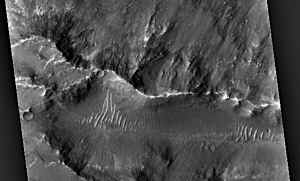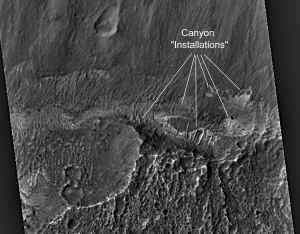Malin "Discovers" Water on Mars --
20 Years too Late While Ignoring the "Good Stuff"
Note: Due to time constraints, these images are being posted with only minimal comment for the time being. A full written analysis will follow in the upcoming days.

Mike Malin and Ken Edgett
At a hastily arranged news conference today, NASA announced through Michael Malin and Ken Edgett of MSSS that it had discovered evidence of water on Mars. As we reported yesterday, this trumpeted "discovery" is hardly new. Dr. Leonard Martin of Lowell Observatory published research in 1980 in the NASA Activities (Dec. 1980, vol. 11, number 12) showing an indisputable water spout on the surface of Mars in Viking imagery. Apparently, at that time it did not suit the interests of the space agency to promote the idea of liquid water on Mars at or just below the surface. For some reason, it now does.
What Malin and Edgett outlined is a rather tame discovery, considering what else is visible on the recently dumped 27,000 MGS images. It is however consistent with a scenario we have developed here at Enterprise over the last few years. As we first reported last year, there is an agenda in place at NASA to promote the idea that Mars is habitable -- yet this agenda is being pushed forth without admitting there might actually be "something" already in place on the Red Planet. We have watched as this careful plan has been laid out in one small step after another. Despite the setbacks of recent months, we have had a steady stream of "revelations" about Mars in the past few years. From the "Mars meteorite" to the highly visible Pathfinder Mission, we have been slowly ramping up to what we believe is an imperative -- for NASA -- manned program in the near future. More recent announcements, like the new plasma propulsion system which promises to cut the time needed for the journey in half, have served to set the stage for what was rumored as a "major announcement."
So we watched today's events with quiet bemusement, as Malin, Edgett and other NASA brass tried to generate some excitement about their findings. The briefing was kicked off with a direct reference to Enterprise and at least one other web based news source on these matters, Kent Steadman's "Cyberspace Orbit" site. Practically the first thing put on the table was the notion that "we have not found hot springs or lakes!"
We assume that the first shot was at us, for our posting a link last night to the water spout story written by Vince Dipietro. But the second shot seemed clearly aimed at Steadman's posting last year of what appears to be an ice lake on Mars he has appropriately dubbed "Lake Steadman." In any event, the whole show droned on in the usual monotonous fashion, as Malin and Edgett et-al seemed to be completely avoiding (or perhaps did not comprehend) the obvious implications of their work.
Their "discovery" centers around the notion that certain features found at latitudes above 30° North and South (in other words, from the those locations poleward, away from the equator) indicate the ejection or runoff of liquid water very near the surface of Mars. The ejection points were also curiously facing away from the sun. They proclaimed themselves to be completely baffled by this finding, since in the conventional model water almost certainly cannot flow at such high latitudes and out of the sunlight. According to the accepted view of Mars, the planet is so cold that any water should be frozen solid to a depth of at least 6 miles. Further, if there was liquid water near the surface, it should only appear near the equator, where it is much warmer, and in areas illuminated by the sun's warming rays. What perplexed them was that these findings were exactly the opposite of the "ideal" conditions for water on Mars. They were also surprised that the features were so geologically "young." (Of course, geologic dating is based on crater counts, a technique that can be completely thrown out in light of the Exploding Planet Hypothesis.)
The problem for them of course, the reason that they cannot make sense of what they have found, is that they refuse to consider (at least publicly) the one idea that can make sense of all this.
Artificiality.
Edgett has already found or at least mentioned the key to unlocking this mystery. The press release for the recent MGS image dump stated in part:
"The ridges seen in places like the Valles Marineris floors are strange. They aren't dunes because they occur too close together, their crests are too sharp, their slopes too symmetrical. They often appear to be a specific layer of material that has undergone erosion -- we just wish we knew what processes are involved that cause this kind of erosion."
These "dunes" of course, are not, as Edgett admits, dunes at all. Some of them seem to be more akin to supports for a Martian subway system. But other features we have been quietly studying for weeks are far stranger. Tipped off by Edgett's statement, we have been scouring the floor of Valles Marineris and being astonished by what we have seen. As the following pages will reveal, these dunes are nothing less than a variety of plumbing fixtures for what must be (as Enterprise principal investigator Richard C. Hoagland pointed out a decade ago in the Monuments of Mars) an ancient, vast, planet wide civilization.
So once again, we are left with the tedious and unrewarding task (will they never appreciate us?!) of putting two and two together for our paradigm challenged pals at NASA/JPL/MSSS. If you have pipes, and you run water through them, what happens when the temperature gets too low?
The pipes burst!
This is why the water is being found in the cold regions pointing away from the sun. Because a system designed for use in a much warmer epoch (maybe only tens of thousands of years ago) is failing when the temperature causes the pipes to expand and burst. This is why the water is being found out of the sun and toward the poles! Because the sun is keeping the water in a liquid, flowing state closer to the equator.
The implications of this are vast. So are the stakes. We suspect that at least Malin already has a clear idea of what is at the base of the canyons on Mars, which is why he pointed us toward them. We believe that in his heart of hearts, Malin and his bosses were hoping that the scientific establishment would take their hint and "discover" what we are about to reveal. After weeks of silence from this "safe" community of Mars researchers, they have upped the ante by dropping an even bigger hint about what needs to be discovered if we are to justify a Mars program in the short term.
They probably didn't plan on us beating the NASA establishment to the punch. Sorry to screw up your well laid plans guys, but it looks like you have to play ball with us if you're going to get to Mars on time (and we know what your schedule is). So watch, read and learn. And let's finally tell everyone why we really have to go to Mars ...
Another "glass tube" network, evidence of exposed piping (they are not sand dunes!) and geometric "installations" on the canyon walls of Coprates Catena


